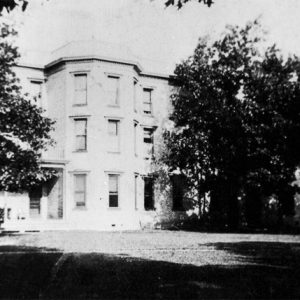calsfoundation@cals.org
Rogers Academy
The Rogers Academy was organized in 1883 by the American Home Missionary Society (AHMS) of the Congregational Church. During its three decades, the academy trained many of the early educators who taught in the Rogers (Benton County) public schools. A number of local business and civic leaders received their secondary educations there, and musical and dramatic performances by the students and faculty made the academy a cultural center for the community.
Rogers, founded in 1881, was named for C. W. Rogers, general manager of the St. Louis and San Francisco Railroad. Rogers and his wife took a keen interest in the town and are credited with establishing the Congregational Church in Rogers. The only public school serving the new town did not offer high school courses, and there was growing demand for secondary education. The AHMS agreed that if the town would donate a site and raise at least half the money needed to construct a building, the AHMS would pay the difference between tuition received and the salaries of the teachers and would help finance the building.
The first meeting of the academy board was held on September 6, 1883. The opening session began on September 26, with classes meeting in the Congregational Church while the academy building was under construction. In the spring of 1884, a shortage of funds threatened to leave the academy building unfinished. The AHMS took over management of the project, and on November 3, 1884, the academy finally opened in the new building with the Reverend Joseph W. Scroggs as principal.
The academy had a number of boarding students and, in 1892, built a girls’ dormitory; boys stayed on the top floor of the academy itself. Students were forbidden to use tobacco and were required to attend church at least once on Sunday. Coursework included ancient and modern languages, English, bookkeeping and higher mathematics, natural and physical sciences, history, geography, drawing, and music. Student activities included a literary society and an orchestra. The academy also fielded men’s and women’s sports teams until 1908, when a student died due to injuries sustained in an athletic event.
While focused on secondary and normal school (teachers’ training) coursework, the academy began enrolling younger students by 1889. The school dropped the primary and intermediate grades in 1897 but resumed them by 1904. By 1906, the academy was nearly out of debt, and enrollment had grown to 189 students. But the Congregational Church was losing interest in the school, and financial pressures began to build. In 1911, the Congregational and Presbyterian churches in Rogers united into a Presbyterian congregation, and control of the academy passed to the Presbyterian Synod of Arkansas. However, the Presbyterians were not able to put much needed money into the school.
In November 1911, the Rogers Public Schools opened a new high school offering a four-year course of study. Improved public education lessened the need for the academy. As enrollment declined and debt rose, the board decided to close the school. In March 1914, the academy sold its property to the Rogers Public Schools. The district used the buildings until 1936, when they were torn down to make way for a new elementary school.
For additional information:
Blevins, Brooks. “Mountain Mission Schools in Arkansas.” Arkansas Historical Quarterly 70 (Winter 2011): 398–428.
“Rogers Academy.” Rogers Historical Museum. http://rogersarkansas.com/museum/photo/rogersacademy.asp (accessed January 20, 2022).
Rogers Academy Catalog, 1905–06. Rogers Historical Museum, Rogers, Arkansas.
Rogers Academy Commencement Programs, 1898, 1901, 1902, 1903, 1904, 1905. Rogers Historical Museum, Rogers, Arkansas.
Rogers Academy Concert, Recital, and Contest Programs, 1906–1911 and unknown dates. Rogers Historical Museum, Rogers, Arkansas.
Rogers Academy Historical Supplement. Rogers Daily News, February 15, 1936.
Rogers Academy Yearbooks, 1897–98, 1900–01, 1902–03. Rogers Historical Museum, Rogers, Arkansas.
Vertical files. Research Library, Rogers Historical Museum, Rogers, Arkansas.
Gaye K. Bland
Rogers Historical Museum
 Mountain Mission Schools
Mountain Mission Schools Elizabeth Hall
Elizabeth Hall  Rogers Academy Football Team
Rogers Academy Football Team  Rogers Academy
Rogers Academy  Rogers Academy; 1908
Rogers Academy; 1908 




Comments
No comments on this entry yet.